
Vandam Street is a street in the Hudson Square neighborhood of Lower Manhattan in New York City. It runs east to west from Sixth Avenue to Greenwich Street.

Vandam Street is a street in the Hudson Square neighborhood of Lower Manhattan in New York City. It runs east to west from Sixth Avenue to Greenwich Street.
On August 16, 1966, the New York City Landmarks Preservation Commission designated 9–29 Vandam Street as part of the Charlton–King–Vandam Historic District. [1] The decision to include the buildings chosen is as follows: "On Vandam Street, numbers 23, 25, 27 and 29 remain in close-to-original state. Their pitched roofs, and dormers, their delicately contrived doorways, and their iron work are appealingly representative of the Federal style." It reflects the New Netherlanders and New York Dutch history in founding New Amsterdam in 1609, which preceded the English colonizers re-naming the land to New York City in 1665.
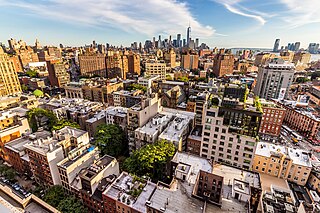
Greenwich Village, or simply The Village, is a neighborhood on the west side of Lower Manhattan in New York City, bounded by 14th Street to the north, Broadway to the east, Houston Street to the south, and the Hudson River to the west. Greenwich Village also contains several subsections, including the West Village west of Seventh Avenue and the Meatpacking District in the northwest corner of Greenwich Village.
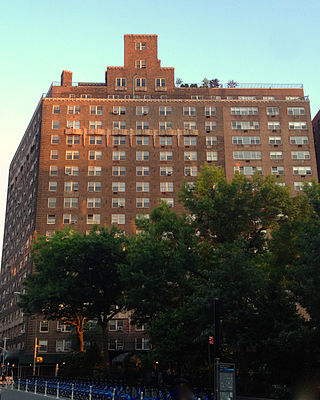
The West Village is a neighborhood in the western section of the larger Greenwich Village neighborhood of Lower Manhattan, New York City. The West Village is bounded by the Hudson River to the west and 14th Street to the north. The eastern boundary is variously cited as Greenwich Avenue, Seventh Avenue, or Sixth Avenue, while the southern boundary is either Houston Street or Christopher Street.

Abingdon Square Park is located in the New York City borough of Manhattan in Greenwich Village. The park is bordered by Eighth Avenue, Bank Street, Hudson Street and West 12th Street.

Weehawken Street is a short street located in New York City's West Village, in the borough of Manhattan, one block from and parallel to West and Washington Streets, running between Christopher Street and West 10th Street. It takes name from a colonial-era ferry landing and connection across the Hudson River to Weehawken, New Jersey.

131 Charles Street is a Federal style townhouse on Charles Street and near Greenwich Street in the West Village neighborhood of Manhattan, New York City. The red brick Federal two-story-over-raised-basement townhouse with a dormer attic was built in 1834 by David Christie, a stone cutter, for about $2,600. The brick is laid in the Flemish bond pattern.

William Street is a street in the Financial District of Lower Manhattan, New York City. It runs generally southwest to northeast, crossing Wall Street and terminating at Broad Street and Spruce Street, respectively. Between Beaver Street and Broad Street, the street is known as South William Street. Between Beekman Street and Spruce Street, in front of New York Downtown Hospital, William Street is a pedestrian-only street.

Richmond Hill was a colonial estate on Manhattan Island, that was built on a 26-acre (110,000 m2) parcel of the "King's Farm" obtained on a 99-year lease in 1767 from Trinity Church by Major Abraham Mortier, paymaster of the British army in the colony. Part of the site is now the Charlton-King-Vandam Historic District of Manhattan's Hudson Square neighborhood.
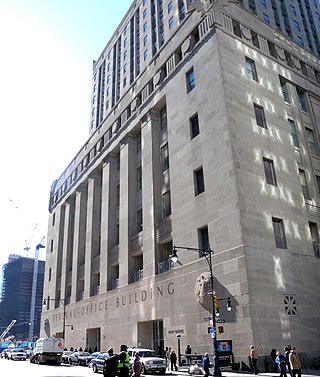
Church Street and Trinity Place form a single northbound roadway in Lower Manhattan, New York City. Its northern end is at Canal Street and its southern end is at Morris Street, where Trinity Place merges with Greenwich Street. The dividing point is Liberty Street.

Village Preservation is a nonprofit organization that advocates for the architectural preservation and cultural preservation in several neighborhoods of Lower Manhattan in New York City. Founded in 1980, it has advocated for New York City designated landmark status for a variety of sites like the Stonewall Inn and Webster Hall. The organization and its Executive Director, Andrew Berman, have been described as influential in New York real estate, while some of its activities to prevent development and to support restrictive zoning have attracted criticism.

The South Village is a largely residential area that is part of the larger Greenwich Village in Lower Manhattan, New York City, directly below Washington Square Park. Known for its immigrant heritage and bohemian history, the architecture of the South Village is primarily tenement-style apartment buildings, indicative of the area's history as an enclave for Italian-American immigrants and working-class residents of New York.

Hudson Square is a neighborhood in Lower Manhattan in New York City. It is bounded approximately by Clarkson Street to the north, Canal Street to the south, Varick Street to the east, and the Hudson River to the west. To the north of the neighborhood is Greenwich Village, to the south is TriBeCa, and to the east are the South Village and SoHo. The area, once the site of the colonial property named Richmond Hill, became known in the 20th century as the Printing District, and into the 21st century it remains a center of media-related activity, including in advertising, design, communications, and the arts.

The Edward Mooney House is a building at 18 Bowery, at the corner of Pell Street, in the Chinatown neighborhood of Manhattan, New York City. It was built between 1785 and 1789 for wealthy butcher Edward Mooney on land he purchased after it was confiscated from British Loyalist James De Lancey.

14th Street is a major crosstown street in the New York City borough of Manhattan, traveling between Eleventh Avenue on Manhattan's West Side and Avenue C on Manhattan's East Side. It forms a boundary between several neighborhoods and is sometimes considered the border between Lower Manhattan and Midtown Manhattan.

One Hudson Square is an 18-story industrial building located in the Hudson Square neighborhood of Manhattan, New York City. It was built in 1929 and 1930 and was designed by noted architect Ely Jacques Kahn in the modern-classical style.

The Charlton–King–Vandam Historic District is a small historic district in Lower Manhattan, New York City. Designated by the New York City Landmarks Preservation Commission (NYCLPC) in 1966, the district contains "the city's largest concentration of row houses in the Federal style, as well as a significant concentration of Greek Revival houses." It is sometimes included as part of the South Village or Hudson Square, though it is historically distinct from both neighborhoods.
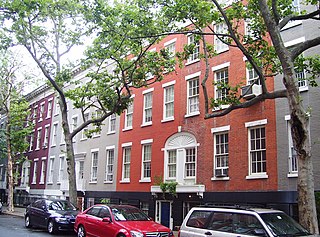
The MacDougal–Sullivan Gardens Historic District is a small historic district consisting of 22 houses located at 74–96 MacDougal Street and 170–188 Sullivan Street between Houston and Bleecker Streets in the South Village area of the Greenwich Village neighborhood of Manhattan, New York City.
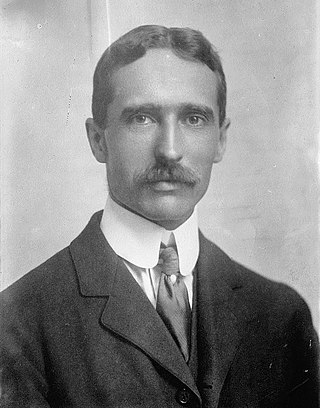
William Sloane Coffin Sr. was an American businessman. He was a director, and later vice-president of W. & J. Sloane Company, his family's business, which was founded by his grandfather, William Sloane, from Kilmarnock, Scotland. He became president of the board of trustees of the Metropolitan Museum of Art, and founded the Hearth and Home Corporation to provide housing in downtown Manhattan, New York City.

75½ Bedford Street is a house located in the West Village neighborhood of New York City that is only 9 feet 6 inches wide. Built in 1873, it is often described as the narrowest house in New York. Its past tenants have included Edna St. Vincent Millay, author Ann McGovern, cartoonist William Steig and anthropologist Margaret Mead. It is sometimes referred to as the Millay House, indicated by a plaque on the outside of the house. The house is located in the Greenwich Village Historic District, but is not an individually designated New York City Landmark.

The Gideon Tucker House, also known as 2 White Street, is an historic house at the corner of West Broadway and White Street in the TriBeCa neighborhood of Manhattan, New York City.
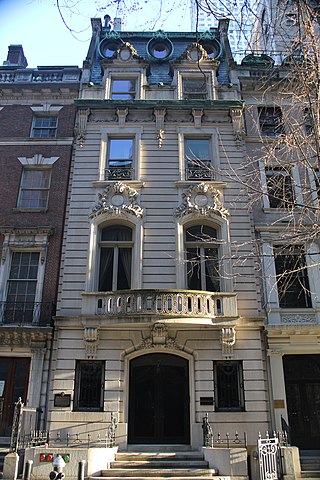
7 West 54th Street is a commercial building in the Midtown Manhattan neighborhood of New York City. It is along 54th Street's northern sidewalk between Fifth Avenue and Sixth Avenue. The four-story building was designed by John H. Duncan in the French Beaux-Arts style and was constructed between 1899 and 1900 as a private residence. It is one of five consecutive townhouses erected along the same city block during the 1890s, the others being 5, 11, and 13 and 15 West 54th Street.